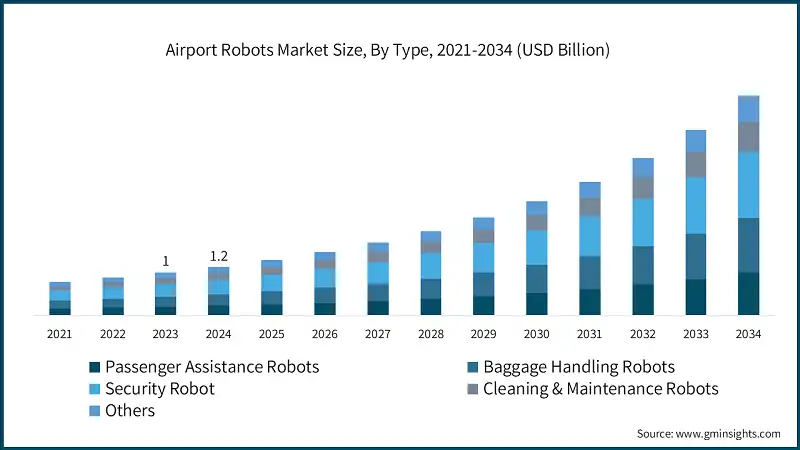Home > Aerospace & Defense > Airport Operations > Airport Infrastructure > Airport Robots Market
Airport Robots Market Analysis
- Report ID: GMI7493
- Published Date: Nov 2024
- Report Format: PDF
Airport Robots Market Analysis
A key restraint in the airport robotics market is the high initial investment and maintenance costs, which can limit adoption, especially for smaller airports. However, there is a significant opportunity in improving operational efficiency, passenger experience, and sustainability through automation, as airports increasingly seek solutions to enhance service quality and reduce costs. Regulatory challenges also exist, as stringent safety and data privacy regulations must be met for the deployment of autonomous systems. Balancing innovation with compliance remains crucial for the successful integration of robotics into airport operations.
Based on type, the airport robots market is segmented into passenger assistance robots, baggage handling robots, security robot, cleaning & maintenance robots, and others. In 2024, the security robot segment accounted for the largest market share with 29.6% share.
Security robots are becoming essential components in airport operations, providing enhanced surveillance, threat detection, and improved safety measures. These robots utilize advanced sensors, cameras, and artificial intelligence technologies to monitor airport premises, identify suspicious activities, and respond to emergencies. By reducing human labor requirements and offering real-time monitoring capabilities, they strengthen the overall security system, particularly in high-traffic areas such as terminals and baggage claim zones.
The increasing focus on airport safety and security, combined with technological advancements, is driving the demand for security robots. These automated systems not only enhance surveillance efficiency but also present cost-effective solutions by minimizing the need for extensive security personnel. As security threats evolve, these robots are becoming more sophisticated, integrating with other security systems to provide comprehensive, automated protection. The trend towards contactless interactions and heightened safety measures, particularly in the post-pandemic era, is further accelerating the adoption of security robots in airports.

Based on category, the airport robots market is divided into humanoid, non-humanoid. The humanoid segment is the fastest-growing segment with a CAGR of 17.6% during the forecast period.
Humanoid robots in airports are designed to assist passengers with information, guidance, and services, providing a personalized experience. These robots are equipped with advanced AI, speech recognition, and natural language processing, allowing them to interact effectively with travelers in multiple languages. They help guide passengers to gates, answer queries, and provide flight information, improving efficiency and customer satisfaction, especially in busy airports.
The demand for humanoid robots is increasing as airports seek to offer enhanced customer service and streamline operations. With their ability to engage passengers and assist with routine tasks, humanoids reduce the burden on airport staff, allowing them to focus on more critical tasks. The growing preference for automation, coupled with the desire for a futuristic airport experience, is driving the adoption of humanoid robots, making them a significant segment in the airport robotics market.

North America airport robots market is expected to reach over USD 2 billion by 2034. North America, with the United States at the forefront, represents a significant market for airport robots. This prominence is attributed to the region's sophisticated infrastructure and strong demand for automation solutions. U.S. airports are progressively implementing robotic systems for various functions, including baggage handling, security operations, and passenger assistance. These implementations aim to enhance operational efficiency and elevate the overall customer experience. The increased emphasis on contactless technologies, particularly in the post-pandemic era, is further accelerating the expansion of the airport robotics market in North America.
China airport robots market is expanding its airport infrastructure and integrating robotics to enhance operations. The government's substantial investment in technology and innovation supports the adoption of autonomous systems, particularly in larger airports. Robotics are increasingly utilized in baggage handling, security checks, and customer service. The rapid growth in air travel, combined with government-backed initiatives, drives demand for advanced technologies to improve efficiency and enhance the passenger experience.
German airports are implementing robotics and automation to enhance operational efficiency and passenger services. Airports such as Frankfurt and Munich are integrating autonomous systems for baggage handling, security, and assistance. The focus is on optimizing resource usage, reducing wait times, and providing a seamless travel experience. Germany's robust technological infrastructure and commitment to sustainability create an ideal environment for deploying robotics in airport operations.
Japan airport robots market is incorporating advanced robotics in airports to improve passenger experience and operational efficiency. Airports like Tokyo Haneda and Narita utilize robots for check-ins, baggage handling, and assisting travelers with special needs. The country's technological advancements and emphasis on service quality drive innovation in airport automation. Robotics also align with Japan's aging population, helping to assist elderly travelers while improving airport operations.
South Korea airport robots industry is investing in airport robotics to increase efficiency and passenger satisfaction, particularly at Incheon International Airport. Robotics are deployed for tasks such as baggage handling, customer assistance, and automated check-ins. South Korea's focus on technological innovation and smart infrastructure encourages the adoption of automation in airports. The country is also prioritizing personalized services for passengers through advanced robotic systems, aiming to create a smoother travel experience.

